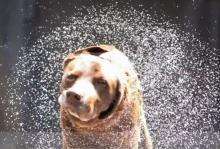October 22, 2010 report
The physics of how wet animals dry themselves (w/ Video)

(PhysOrg.com) -- Scientists using slow-motion movie cameras have been trying to discover the physics behind the "wet dog shake."
Physicist Andrew Dickerson of the Georgia Institute of Technology in Atlanta in the US and colleagues wanted to determine the optimal speed at which dogs and other hairy or furry animals should oscillate to shake water out of their fur most efficiently.
Dickerson’s team determined the conditions in which water drops are ejected by considering the balance of centripetal forces and surface tension on the drops. They likened the forces involved in the shaking or oscillating of wet, hirsute mammalian bodies to the spin cycle of a washing machine.
Centripetal force varies with the distance from the center of the body. Using this information, the team derived a mathematical model to calculate the optimum frequency of the oscillations, and their equation gave them a frequency value of R-0.5, where R is the radius of the animal. This means smaller animals must oscillate faster to generate enough force to shake off the water.
To test their model they filmed a wide range of wet dogs and other animals ranging in size from mice to bears, shaking themselves dry, and then used the video recordings to determine the period of oscillation of the shake. They supplemented the videos with fur-particle tracking and X-ray cinematography.
The value they found for labrador dogs was around 4.3 Hz, and the frequency increased for smaller animals, with cats shaking at 6 Hz and mice at 27 Hz, while it decreased with larger animals such as a grizzly bear at 4 Hz. The relationship is not linear but the frequency asymptotically approaches a 4 Hz limit as the size of the animal increases.
Their results, pre-published on arXiv, also showed their equation was incorrect and the value for the frequency of oscillation is actually R0.75. Dickerson suggested the discrepancy may be due to their calculating the radius as being from the center of the animal to the skin, but he said "the fur might make a difference."
More information: The Wet-Dog Shake, Andrew Dickerson, Grant Mills, Jay Bauman, Young-Hui Chang, David Hu, arXiv:1010.3279v1 [physics.flu-dyn] arxiv.org/abs/1010.3279
© 2010 PhysOrg.com
















